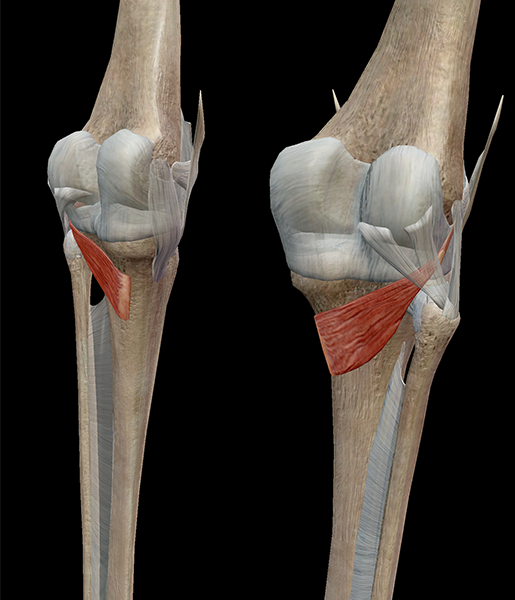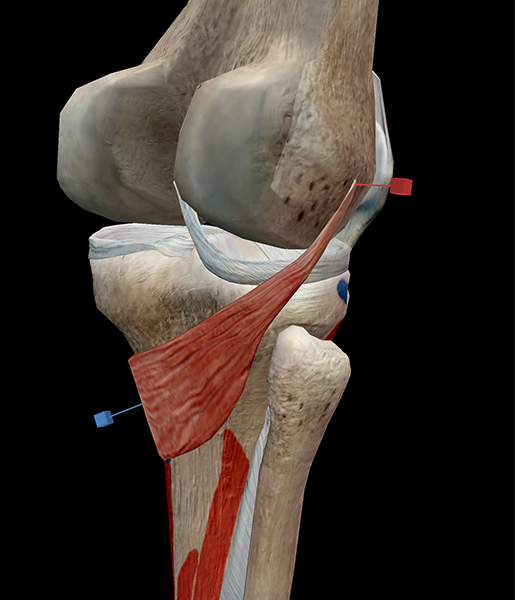Posted on 11/13/12 by Courtney Smith
I have a real fascination with underdogs: the little guys who manage to pull off the incredible when the bigger guys usually get all the glory. The same goes for the little muscles in our bodies that somehow stabilize entire joints, or are primarily responsible for certain actions.
The popliteus muscle is a nifty little thing (emphasis on little). In comparison to most of the other muscles in the distal leg, the popliteus is small. Why do I like this muscle so much? It's a total underdog. Thanks to the popliteus, you're able to bend your knees, which means you can walk, run, jump, and cross your legs comfortably (like the way I'm sitting right now).
 Image captured from Muscle Premium.
Image captured from Muscle Premium.
The popliteus (pronounced pop-lit-ee-us) is a thin, flat, triangular muscle in the posterior compartment of the distal leg region. It helps to form the lower part of the popliteal fossa, or the pit of the knee.
Without this little muscle, you'd be quite locked-legged. Let's take a look at it.
Stand up straight and lock your knees. Right now, the popliteus is not in use. However, when you move your knee to take a step, the popliteus is the muscle that unlocks the joint and flexes the knee. When the knee flexes, the popliteus helps to rotate the tibia inward. It also assists in medial rotation of the knee.
 Image captured from Muscle Premium.
Image captured from Muscle Premium.
Like the anconeus muscle at the elbow joint, the popliteus acts as a stabilizer for the knee joint. When the knee flexes, it is the popliteus that first acts, laterally rotating the femur on the tibia.
The popliteus originates on the lateral surface of the lateral femoral condyle, the oblong eminences at the end of the femur. It inserts on the posterior surface of the proximal tibial shaft. Think of the popliteus as a sort of butterfly bandage over a wound: the popliteus stretches over the gap between the femoral condyles and their tibial facets of articulation (see image, left).
Let's face it: the knees take a pounding over the course of a lifetime. Because the popliteus is involved in knee flexion and medial rotation, it, too, is susceptible to many injuries.
Popliteus tendinitis is one of the most common injuries. It is an inflammation of the tendons surrounding the popliteus, which causes tenderness along the course of the proximal popliteus tendon and pain with resisted external rotation. Overworking the knees (e.g., excessive running) is one of the most common causes of tendinitis.
Straining the popliteus is another incredibly common injury. A muscle strain is actually a tear (we know how I feel about those), which can cause incredible pain, sometimes worse than a broken bone, and feeling that the knee does not fully extend or a "blocked up" feeling on flexion of the knee. Popliteus strains are often linked with acute injuries, like falls or car accidents, chronic overuse of the knees, posterior cruciate ligament (PCL) tears, or muscle imbalance. Not to mention that any strain of the knee will involve the popliteus in some capacity.
The easiest treatment for a muscle strain is RICE:
Rest.
Ice to the injured area. The normal rule is 20 minutes on, 20 off.
Compression. Wrap the injured area with Ace (tm) bandage.
Elevation. Severe strains may require chiropractic assistance, and in some cases surgery.
Be sure to subscribe to the Visible Body Blog for more anatomy awesomeness!
Are you an instructor? We have award-winning 3D products and resources for your anatomy and physiology course! Learn more here.
Additional Sources:
http://pages.uoregon.edu/esorens1/hphy362.pbwiki.com/Knee+Pathologies.html#PT
http://www.ncbi.nlm.nih.gov/pubmed/20086537
http://www.livestrong.com/article/336699-stretches-to-help-popliteus-tendinitis/
When you select "Subscribe" you will start receiving our email newsletter. Use the links at the bottom of any email to manage the type of emails you receive or to unsubscribe. See our privacy policy for additional details.
©2025 Visible Body. All Rights Reserved.